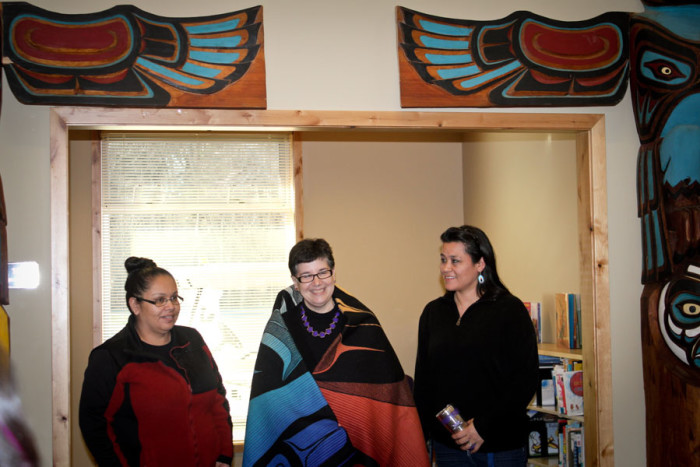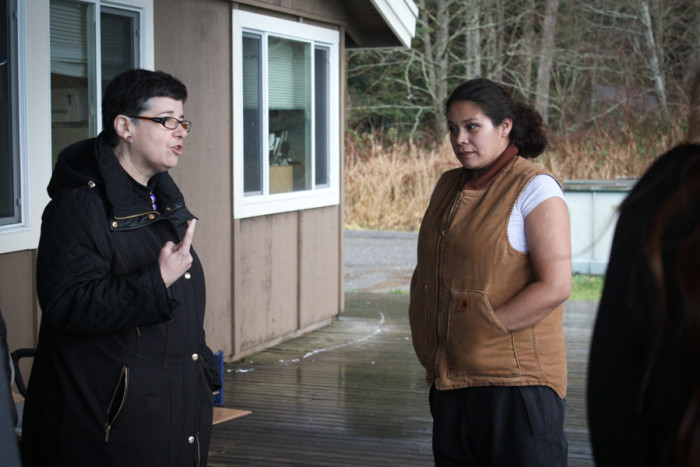
I wasn’t sure how to feel when I got the email a few weeks back asking if I would join University of Washington President Ana Mari Cauce on a visit to the place where I grew up, the Lummi Indian Reservation, outside Bellingham.
I was invited to go because I am one of two students in the entire UW that identifies as Lummi — and I’m the only one who is enrolled in the tribe and grew up on the reservation.
That past is one that is often hard to reconcile with my life in Seattle as university student.
Not very long ago I was living on the reservation, couch surfing and not always sure where my next meal was coming from. Like many people I knew there, I was battling drug and alcohol addiction and extreme poverty. So far this year alone, I know of at least three people under the age of 30 who have died of drug overdoses on the reservation.
A Different World
I was conflicted as to how that would feel going back into my old community, where I had been at one of the lowest points of my life, but this time in Cauce’s “entourage” as a UW representative.
I go back to the reservation to visit a lot, but I don’t talk much about my life at UW. It’s a world that’s totally foreign to my friends and family. For example, when I found out recently that I’d been accepted to the Evans School for Public Policy and Governance recently, I hesitated to call my family to tell them the good news. I didn’t know if they would understand the gravity of it. Some people would just be disappointed because they’ve wanted me to move back home for a long time.
According to the invitation, this would be”the first time in over 18 years” that a UW president visited tribal lands. This is problematic, but not at all surprising. There are 28 Indian Reservations in the state of Washington. Approximately 22% of Native people live on reservations – but how often do public figures like Cauce actually come to visit?
I had a lot of questions about her motives in coming. Why had she suddenly decided to take a full day to go to the reservation, and why go to our reservation in particular? What was she after?

And why did they really invite me?
Would I just be a ‘prop” to show off the fact that at least one person had overcome the inter-generational trauma, the addiction, the poverty and the abuse, and actually made it to UW?
How would I be perceived by people I knew from the reservation when I showed up on this formal visit?
The Visit
Cauce said that her goal was to build partnerships between the Lummi Nation and the University of Washington.
Not surprisingly, that meant most of the day was spent touring “the strip” where all the tribal money is spent. It’s a nice area, but it’s literally miles away from where most residents live, and where I grew up myself, further out on the peninsula.
The first stop on our visit was the Lummi Shellfish Hatchery. Imagine a chemistry lab on steroids with an overwhelming smell of saltwater, clams, oysters and geoducks. The hatchery produces about four million oysters every year, and Cauce and others see potential for UW agricultural and environmental departments to assist in those efforts.
Our next stop was the Lummi Tribal Administration Building. The structure has long been a symbol of frustration for my family and myself, with the tribe spending huge amounts of money on an extravagantly beautiful building, while the homeless population is increasing, recovery housing has a waiting list a mile long, and tribal members still get no direct financial compensation — also know as ‘per capita’ — when the tribe turns a profit (despite a hugely successful tribally owned casino).
We spent a better part of the day there. The building is beautiful no doubt, but I have always had a lingering notion that this was a big part of its purpose — to show off to company.
An important conversation we did have was the different needs of Native American students on the reservation in comparison to Native American students in the city.
Culture on the reservation presents several different types of challenges to Native students in search of an education at the University of Washington. — close family bonds, small community, traditional lifestyle and financial barriers just to name a few.
It took me close to a year of going back and forth from Seattle to Lummi to get my footing in the city. The cultures are worlds apart and the transition took time. Going from having a very large family who you see and spend time with everyday to being alone all the time in the city is not easy. One’s “family” on the reservation isn’t just immediate family, but countless cousins, aunts, uncles, grandparents, and community members who all play important roles.

Barriers to Native Americans from the reservation accessing higher education need to come down.
But people are already breaking barriers to education on the reservation.
During our visit to the Northwest Indian College we got to see the college’s multiple-award-winning rocket program. Apparently the school had beat out MIT in competitions three times. The college’s library has a Vine Deloria section that included the Native author’s entire personal library as well as his own writings. The campus was beautiful and the faculty warm and welcoming. The school offers four bachelor’s degree programs and is working to expand in the future.
Seeing a new side of home
As our visit came to a close I began to rethink my role in being there. Maybe I wasn’t just eye candy for an official visit. Maybe it was a chance to see a side of my home that I had never allowed myself to appreciate before.
The amount of growth and innovation that is happening in the Lummi Nation is incredible. In addition to the places we visited, the tribe is building a brand new school, a new housing development, another one for people getting out of prison and treatment.
Are there plenty of areas in need of improvement? Yes.
Has the leadership focused on repairing the most vulnerable parts community? In my opinion, they have not — but they are starting to do better.
But overall, the Lummi Nation, a sovereign nation, is starting to take care of it’s own and create positive change.
I haven’t been in Seattle long, but my old home already it looks better than it did in the memories that I have from the years I struggled there.
I left at the end of the day wondering if Ana Mari Cauce’s visit would really amount to anything. The gesture of coming was nice, but what tangible impacts would there be?
It is not enough to acknowledge ancient tribal lands on which the city of Seattle sits. It is not enough for the city council to change the name of a holiday in respect to Indigenous people. More effort must be put into building real relationships with Native peoples on reservations.
Because when I leave, how many students who grew up on the Lummi Reservation will there be at UW?
Zero.

